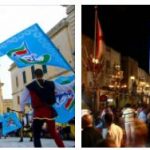Kinshasa is the center of contemporary cultural life. The Academy of Fine Arts (Académie des Beaux-Arts) is located there, the most important art academy in the Central African region at university level. There is also an active theater scene in Kinshasa based on community and youth initiatives.
The National Museum (Musée National de Kinshasa), which opened in the capital in 2019, presents a comprehensive collection of traditional and modern forms of culture, taking into account the country’s ethnic diversity.
Traditional forms of handicraft include painted masks and richly ornamented masks, carved wooden sculptures, head and body decorations, textiles and wickerwork.
Before the colonial era and thus before the intensive contact with European culture from the 19th century, the visual arts, music and literature were closely linked to religious and spiritual life. The wide range of contemporary painting and sculpture is a symbiosis between traditional models and modern influences. Also internationally known are painters such as Lema Kusa ( * 1944 ), Claudy Khan ( * 1958 ), Roger Botembe ( * 1959, † 2019 ) and Henri Kalama Akulez ( * 1973 ) as well as sculptors such as Alfred Liyolo ( * 1943, † 2019 ) and Freddy Tsimba ( * 1967 ). The main representative of so-called popular art, which emerged in Kinshasa in the 1970s, is the self-taught painter Chéri Samba ( * 1956 ).
According to thefreegeography, Congolese literature is presented in French, the national language Lingala and other regional languages. Her main focus is on the historical reappraisal of the colonial era and the examination of the current political situation in the country threatened by collapse. VY Mudimbe wrote in his novels, stories, poems and essays about the cultural turmoil and the difficult search for identity in post-colonial Congolese society. Other well-known writers beyond the borders of the country are SL Tansi , Clémentine Nzuji ( * 1944 ), Marie-Jeanne Tshilolo Kabika (* 1949), Maguy Rashidi-Kabamba (* 1960) and Bona Mangangu ( * 1961 ). In Koli Jean Bofane ( * 1954 ), who lives in Belgium, is one of the authors who left their country under the repressive Mobutu regime. His multiple award-winning novels such as “Sinusbögen überm Kongo” (2008, German 2013) have been translated into several languages.
In the pre-colonial period there were different, regionally varying forms of traditional music. These were used in the form of religious chants, especially on ritual occasions. In addition to drums, the rattle, the mbira, a thumb piano, the kora, a double harp, and the balafon, a xylophone, were among the most important instruments. At the beginning of the 1940s, the soukous music style that is still typical today, also known as rumba congolaise or rumba lingala, emerged. The soukous, which draws on the traditional music of the Congo region, usually consists of a singing part and an instrumental dance part. The saxophone, drum and electric guitar were later added to the main instruments of guitar, drums, accordion and clarinet. He continued to develop in various styles, e.g. B. Tabu Ley Rochereau ( * 1937, † 2013 ), Papa Wemba ( * 1949, † 2016 ), Kanda Bongo Man ( * 1955 ) and Koffi Olomide ( * 1956 ) became very popular.
Internationally known is Congolese jazz with bands like “African Jazz” or “OK Jazz” or the world music band “Staff Benda Bilili”, which has its roots in street music. With the Orchester Symphonique Kimbanguiste, known from the documentary »Kinshasa Symphony« (2010), the country has the only symphony orchestra in Central Africa.
The dominant sport – both active and passive – is football. Boxing and catching are also popular.
Democratic Republic of the Congo – World Heritage Sites
World Heritage Sites
- Virunga National Park (1979)
- Garamba National Park (1980)
- Kahuzi Biega National Park (1981)
- Salonga National Park (1984)
- Okapi Wildlife Sanctuary (1996)
Lubumbashi
Lubumbashi [- ba ʃ i] until 1966 Elisabethville [- vil], capital of Katanga Province, Democratic Republic of Congo, near the border to Zambia, 1 230 m above sea level, with (2004) 1.3 million residents second largest city in the country.
Seat of a Catholic Archbishop and the Orthodox Metropolitan for Central Africa; University (founded in 1955), museum (traditional African art). Located in an agricultural area on the Benguela Railway, Lubumbashi developed into the center of the copper belt; Mining and smelting of copper and cobalt ores, textile and food industry, cigarette factory; international Airport.
Lubumbashi was founded in 1910 near a copper ore mine.
Kinshasa
Kinshasa [ k ɪ n ʃ a ː za ] (Leopoldville to 1966), capital of the Democratic Republic of Congo, on the left bank of the lower Congo, with (2004) 7.3 million residents.
Administrative, economic and cultural center of the country. From 1923 Kinshasa was the capital of the Belgian Congo.









